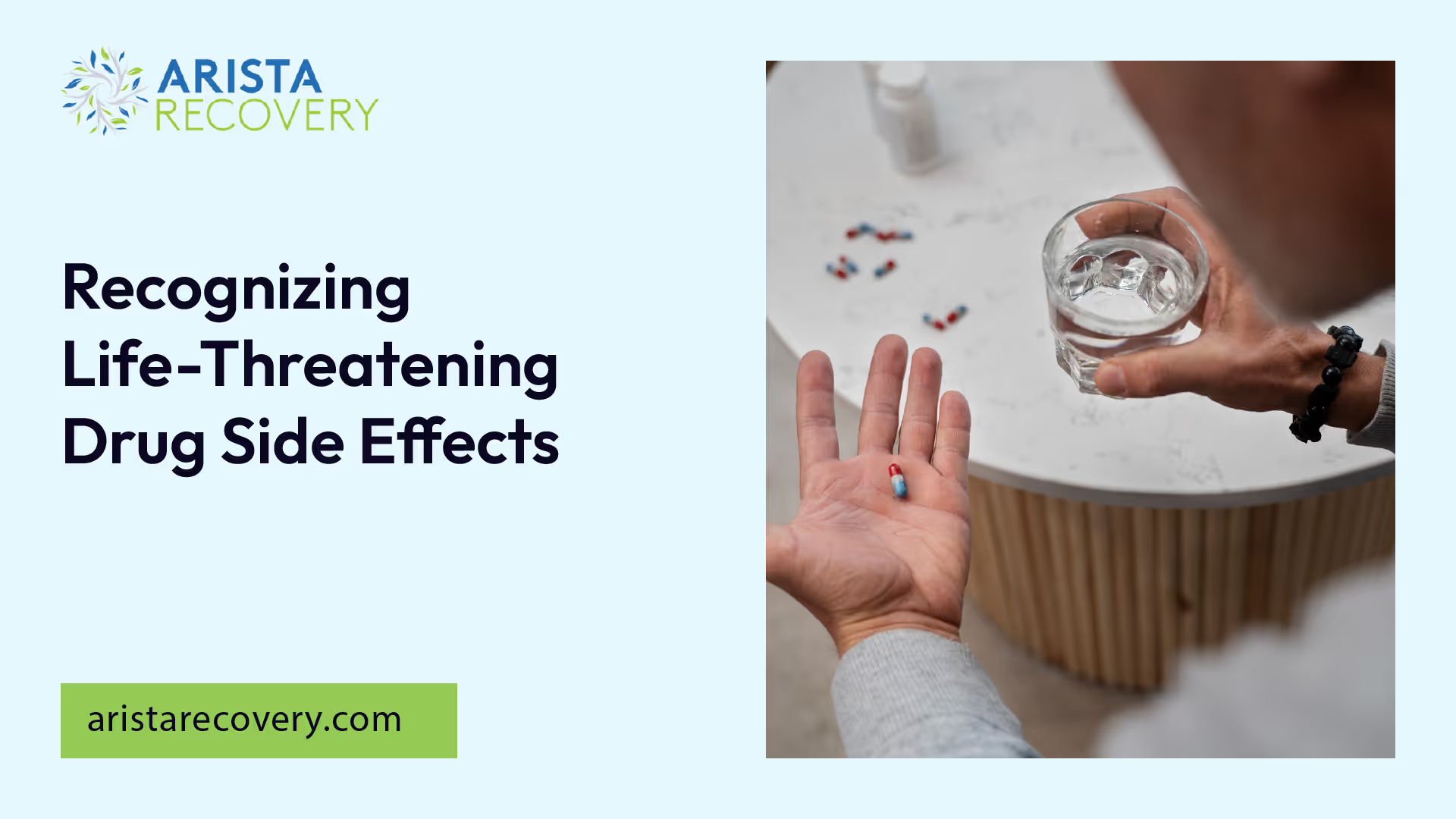Recognizing Life-Threatening Drug Side Effects


Understanding Adverse Drug Reactions
Adverse drug reactions (ADRs) are unintended or harmful responses to medications. Recognizing the types and understanding the factors influencing these reactions is crucial for safeguarding health, particularly in cases where life-threatening drug side effects may occur.
Types of Adverse Reactions
Different drugs can produce various effects in the body, which often differ from person to person. The major types of adverse reactions include:
Factors influencing how an individual reacts to drugs can vary significantly.
Reaction TypeDescriptionAllergic ReactionsImmune response to a drugToxic ReactionsEffects from overdose or drug buildupSide EffectsSecondary non-intended effectsWithdrawal ReactionsSymptoms from abrupt cessation of use
Factors Influencing Reactions
Numerous factors can influence how a drug affects an individual. Understanding these factors can help predict and manage potential adverse reactions.
By comprehensively understanding the types of adverse reactions and the factors that influence them, individuals can better navigate the complexities of medication use. This knowledge is particularly important in identifying and responding to life-threatening drug side effects.
Life-Threatening Drug Side Effects
When considering the impact of medications on health, it's essential to understand the potential life-threatening side effects that can arise. The following sections detail significant reactions that may occur due to certain drugs.
Anaphylactic Reactions
Anaphylaxis is a severe allergic reaction that may occur after taking medication. Symptoms can escalate rapidly and include difficulty breathing, swelling of the throat, and a rapid drop in blood pressure. An allergic reaction to drugs can vary from mild manifestations like itching and rash to severe anaphylactic responses. This reaction necessitates immediate medical attention, as it can be life-threatening.
Symptoms of AnaphylaxisDescriptionDifficulty BreathingNarrowing of the airways causes shortness of breath.SwellingChanges in throat or face lead to potential choking.Rapid Heart RateThe body responds to stress, causing increased pulse.Skin ReactionsHives or swelling due to inflammatory response.
Internal Bleeding Risks
Certain medications, particularly anticoagulants like warfarin, pose serious risks regarding internal bleeding. If not monitored correctly, these drugs can lead to life-threatening situations where excessive bleeding occurs. Warfarin is used to prevent blood clots but can cause severe internal bleeding in inappropriate circumstances.
MedicationRisk of Internal BleedingWarfarin (Coumadin, Jantoven)HighNon-Steroidal Anti-Inflammatory Drugs (NSAIDs)ModerateAntiplatelet DrugsModerate to High
Severe Muscle Complications
Statins, commonly prescribed to lower cholesterol, can sometimes lead to severe muscle complications, including rhabdomyolysis. This condition involves the breakdown of muscle tissue and can result in serious complications such as liver damage and kidney failure, potentially leading to death [3]. Recognizing the signs of muscle pain and seeking medical advice promptly is essential.
Type of StatinRisk of Muscle ComplicationsSimvastatin (Zocor)Moderate to HighRosuvastatin (Crestor)ModerateLovastatin (Mevacor)ModerateAtorvastatin (Lipitor)Low to Moderate
Understanding life-threatening drug side effects is crucial for ensuring safety when using medications. Awareness of the risks associated with specific drugs can help in making informed decisions about treatment options.
High-Risk Medications
Certain medications carry significant risks of life-threatening side effects. Understanding these risks is important for anyone considering or currently using these drugs. The following section discusses three classes of high-risk medications: ACE inhibitors, statins, and biguanides.
ACE Inhibitors
ACE (Angiotensin-converting enzyme) inhibitors, including medications like lisinopril (Prinivil), captopril (Capoten), enalapril (Vasotec), and ramipril (Altace), are often prescribed to manage high blood pressure and heart conditions. However, these medications can rarely cause angioedema, a potentially life-threatening reaction characterized by swelling of the deep layers of the skin, often around the eyes and lips, and in some cases, the throat. This swelling can lead to difficulty breathing if left untreated [3].
ACE InhibitorCommon UsePossible Life-Threatening Side EffectLisinopril (Prinivil)Hypertension, Heart FailureAngioedemaCaptopril (Capoten)Hypertension, Heart FailureAngioedemaEnalapril (Vasotec)Hypertension, Heart FailureAngioedemaRamipril (Altace)Hypertension, Heart FailureAngioedema
Statins
Statins are a class of medications commonly used to lower cholesterol levels. Notable examples include simvastatin (Zocor), rosuvastatin (Crestor), lovastatin (Mevacor), and atorvastatin (Lipitor). These drugs can sometimes cause severe muscle pain, leading to a serious condition called rhabdomyolysis. Rhabdomyolysis results in the breakdown of muscle tissue and can lead to complications such as liver damage, kidney failure, and even death [3].
StatinCommon UsePossible Life-Threatening Side EffectSimvastatin (Zocor)Lower CholesterolRhabdomyolysisRosuvastatin (Crestor)Lower CholesterolRhabdomyolysisLovastatin (Mevacor)Lower CholesterolRhabdomyolysisAtorvastatin (Lipitor)Lower CholesterolRhabdomyolysis
Biguanides
Biguanides, particularly Metformin, are frequently prescribed to manage diabetes. Though effective, these medications can rarely cause lactic acidosis, a severe condition characterized by the buildup of lactic acid in the blood. Lactic acidosis can lead to hypotension, resulting in a dangerous drop in blood pressure, and hypothermia [3].
BiguanideCommon UsePossible Life-Threatening Side EffectMetforminDiabetes ManagementLactic Acidosis
Awareness of these high-risk medications and their potential life-threatening side effects can empower patients and healthcare providers to make informed decisions and take appropriate precautions.
Potentially Harmful Antibiotics
Certain antibiotics, particularly fluoroquinolones such as levofloxacin and ciprofloxacin, can lead to serious side effects. Understanding these potentially harmful effects is key to ensuring safe medication practices.
Tendon Injuries
Fluoroquinolones have been associated with severe and often irreversible tendon injuries. These injuries can occur in various tendons, with the Achilles tendon being the most commonly affected. The risk of tendon damage increases significantly in certain populations, including older adults and individuals taking corticosteroids.
AntibioticRisk of Tendon InjuryLevofloxacin (Levaquin)HighCiprofloxacin (Cipro)High
Both levofloxacin and ciprofloxacin have been less commonly prescribed due to these risks.
Peripheral Neuropathy
Another significant risk associated with these antibiotics is peripheral neuropathy. This condition can result in tingling, numbness, or pain in the extremities and can be debilitating. The symptoms may persist even after discontinuing the medication, leading to long-term complications.
AntibioticRisk of Peripheral NeuropathyLevofloxacin (Levaquin)HighCiprofloxacin (Cipro)High
The potential for developing this condition has contributed to the decreased use of these medications in clinical settings.
Aortic Ruptures
Fluoroquinolones are also implicated in the risk of aortic ruptures or tears. This life-threatening side effect is particularly concerning, as it can lead to severe internal bleeding and often requires immediate surgical intervention.
AntibioticRisk of Aortic RupturesLevofloxacin (Levaquin)HighCiprofloxacin (Cipro)High
Due to the serious nature of these effects, healthcare providers are encouraged to carefully consider the necessity of prescribing fluoroquinolones and to discuss potential risks with patients [4].
Risks of Painkillers
Painkillers, commonly used for relief from various pains, carry significant risks, especially when misused or taken in excessive doses. Understanding these potential complications helps in recognizing life-threatening drug side effects associated with their use.
Liver & Kidney Damage
Acetaminophen, known commercially as Tylenol, is a widely used painkiller that can cause severe liver damage when taken beyond recommended amounts. Non-steroidal anti-inflammatory drugs (NSAIDs), such as ibuprofen (Motrin, Advil) and naproxen (Aleve), can also lead to kidney damage over time.
The potential for liver and kidney complications underscores the importance of adhering to dosage guidelines and avoiding prolonged use without medical supervision.
Painkiller TypeRisk of Liver DamageRisk of Kidney DamageAcetaminophenHighLow to ModerateIbuprofenLowHighNaproxenLowHigh
Gastrointestinal Bleeding
Another serious risk associated with NSAIDs is gastrointestinal bleeding. This can manifest as ulcers, stomach bleeding, or serious digestive tract complications. Individuals using NSAIDs, especially in long-term or high-dose scenarios, are at a heightened risk of experiencing life-threatening bleeding events [3].
Patients are advised to report any persistent stomach pain or unusual gastrointestinal symptoms to their healthcare provider promptly.
Painkiller TypeRisk of Gastrointestinal BleedingAcetaminophenLowIbuprofenHighNaproxenHigh
Cardiovascular Complications
Chronic use of certain painkillers, particularly NSAIDs, can lead to cardiovascular complications, including increased risk of heart attack and stroke. Prolonged use raises blood pressure, adding strain to the cardiovascular system.
Understanding these risks is crucial for anyone who frequently utilizes pain medications, and patients should discuss alternative pain management options with their healthcare providers.
Painkiller TypeRisk of Cardiovascular ComplicationsAcetaminophenLowIbuprofenModerateNaproxenHigh
Awareness of these potential risks can lead to safer practices when managing pain and reinforce the necessity of consulting with healthcare professionals before starting or continuing painkiller usage.
Preventative Measures for Adverse Reactions
Ensuring the safety of medications involves several preventative measures. Healthcare authorities maintain oversight through regulatory surveillance programs and encourage report submission and evaluation to identify life-threatening drug side effects.
Regulatory Surveillance Programs
The Food and Drug Administration (FDA) operates a post-marketing surveillance program known as MedWatch. This program is essential for gathering reports of unwanted drug effects from healthcare professionals in real-world settings. It helps monitor side effects that were not initially identified during clinical trials.
The FDA's Adverse Event Reporting System (FAERS) collects various reports, including adverse events, medication errors, and product quality complaints. This database supports the FDA's post-marketing safety surveillance efforts for both drugs and therapeutic biologics [5].
ProgramPurposeMedWatchGather real-world reports of side effectsFAERSSupport safety surveillance with comprehensive reports
Report Submission and Evaluation
To actively manage drug side effects, individuals are encouraged to educate themselves about potential side effects associated with their medications. Collaborating with healthcare providers is crucial for adjusting dosages, switching medications, or considering lifestyle changes to alleviate adverse reactions.
Users of medications are urged to report any side effects experienced to the FDA’s MedWatch program. This initiative is vital to tracking serious problems associated with human medical products, including drugs. Reporting not only aids in individual patient care but contributes to broader efforts to enhance medication safety.
Educating oneself and maintaining open communication with healthcare providers create a proactive approach to managing and preventing life-threatening drug side effects.
References
[2]:
[3]:
[4]:
[5]:
[6]:
You’re not alone in this.
When mental health challenges and addiction intersect, it can feel isolating. At Arista, we offer compassionate, evidence-based, and trauma-informed care to help you heal, grow, and move forward.
You’re not alone in this.
When mental health challenges and addiction intersect, it can feel isolating. At Arista, we offer compassionate, evidence-based, and trauma-informed care to help you heal, grow, and move forward.
Support that moves with you.
You’ve taken a brave first step. At Arista Recovery, we’re here to help you continue with best-in-class care designed for long-term healing and support.
.webp)






